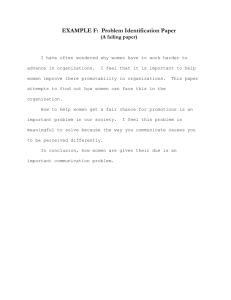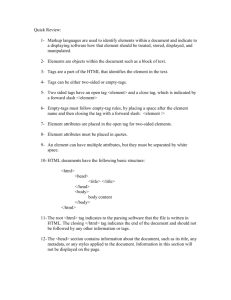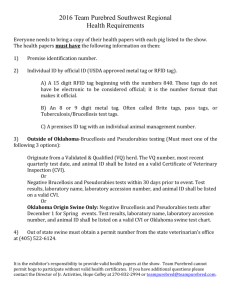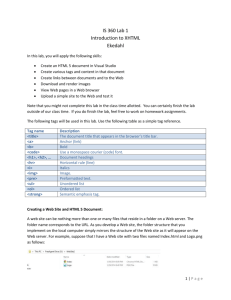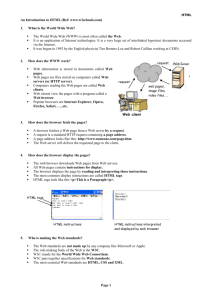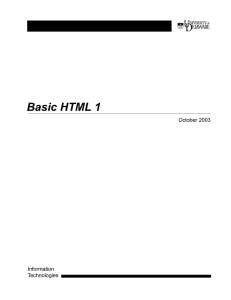Web Design Teacher Tips-
advertisement
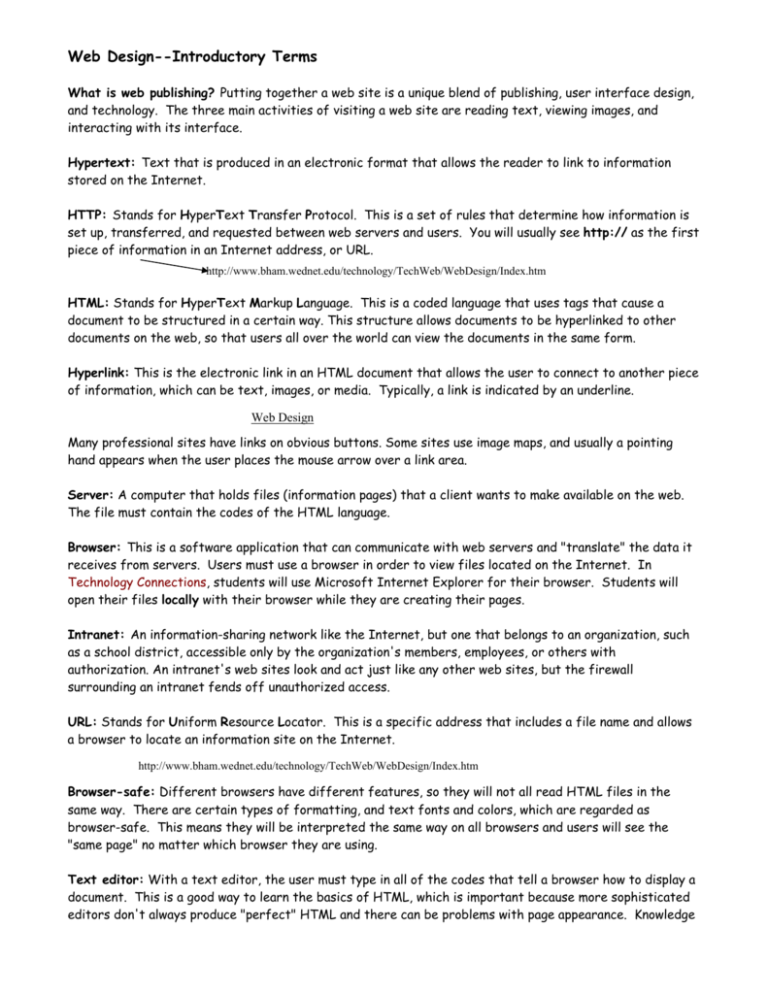
Web Design--Introductory Terms What is web publishing? Putting together a web site is a unique blend of publishing, user interface design, and technology. The three main activities of visiting a web site are reading text, viewing images, and interacting with its interface. Hypertext: Text that is produced in an electronic format that allows the reader to link to information stored on the Internet. HTTP: Stands for HyperText Transfer Protocol. This is a set of rules that determine how information is set up, transferred, and requested between web servers and users. You will usually see http:// as the first piece of information in an Internet address, or URL. http://www.bham.wednet.edu/technology/TechWeb/WebDesign/Index.htm HTML: Stands for HyperText Markup Language. This is a coded language that uses tags that cause a document to be structured in a certain way. This structure allows documents to be hyperlinked to other documents on the web, so that users all over the world can view the documents in the same form. Hyperlink: This is the electronic link in an HTML document that allows the user to connect to another piece of information, which can be text, images, or media. Typically, a link is indicated by an underline. Web Design Many professional sites have links on obvious buttons. Some sites use image maps, and usually a pointing hand appears when the user places the mouse arrow over a link area. Server: A computer that holds files (information pages) that a client wants to make available on the web. The file must contain the codes of the HTML language. Browser: This is a software application that can communicate with web servers and "translate" the data it receives from servers. Users must use a browser in order to view files located on the Internet. In Technology Connections, students will use Microsoft Internet Explorer for their browser. Students will open their files locally with their browser while they are creating their pages. Intranet: An information-sharing network like the Internet, but one that belongs to an organization, such as a school district, accessible only by the organization's members, employees, or others with authorization. An intranet's web sites look and act just like any other web sites, but the firewall surrounding an intranet fends off unauthorized access. URL: Stands for Uniform Resource Locator. This is a specific address that includes a file name and allows a browser to locate an information site on the Internet. http://www.bham.wednet.edu/technology/TechWeb/WebDesign/Index.htm Browser-safe: Different browsers have different features, so they will not all read HTML files in the same way. There are certain types of formatting, and text fonts and colors, which are regarded as browser-safe. This means they will be interpreted the same way on all browsers and users will see the "same page" no matter which browser they are using. Text editor: With a text editor, the user must type in all of the codes that tell a browser how to display a document. This is a good way to learn the basics of HTML, which is important because more sophisticated editors don't always produce "perfect" HTML and there can be problems with page appearance. Knowledge of the code language can enable a user to fix some of the problems. Technology Connections students will use MS Windows Notepad as their first text editor. Other kinds of editors include: • Dedicated HTML editors, like HomeSite, use automated tags. Tech Connections students will use HomeSite after they learn HTML basics. • WYSIWYG HTML editors, which allow someone who knows nothing about HTML to create web pages. See a longer explanation at the end of this list of terms. HTML Tag: The tag contains a direction (message) that tells a browser how to display information, and is enclosed in angle brackets (< >). Almost all tags come in pairs, the first being the opening tag and the second being a closing tag. The information that the tag controls is between the tags, and the closing tag always contains a forward slash (/) which stops the function that the tag controls. Tag Name Opening Tag Tag Attributes <body bgcolor="#FFFBF0" text="#003366"> You place the content of your page between the body tags. Closing Tag </body> Attribute: A function that is contained within the brackets of a tag and controls features while that tag is in effect. For instance, Background can be included within the Body tag and will cause the same background to fill the whole page. Extension: In a file name, the letters after the dot (period) that identify the file type. In HTML, all files must end with .htm http://www.bham.wednet.edu/technology/TechWeb/WebDesign/Index.htm Directory: An organizational unit, or container, used to organize folders and files into a hierarchical structure. You can think of a directory as a file cabinet that contains folders that contain files. Many graphical user interfaces use the term folder instead of directory. Subdirectory: directory below another directory. Every directory except the root directory is a subdirectory. Index.htm: The starting or "home" page for a web site must be given this name. A browser searches the web file to find this name to determine the starting page of a web site. Image map: An image map divides an image into different areas that a user can click, and each links to a different web address. There can be several such links within one image, and a "map" within the HTML specifies the pixel coordinates where the links are located. An image map can work well with a graphic that has distinct areas. Photographs do not always make good image maps. ABOUT WEB DESIGN PROGRAMS: Software programs referred to as WYSIWYG’s (What You See Is What You Get,” pronounced "whizzy-wig) are very popular. The user produces a visible web page document while the software creates the source language (HTML) that resides "behind" the page. Most WYSIWYG programs are subject to occasional formatting errors, which are difficult to fix unless the user knows something about HTML. Students in Tech Connections will not be working with a WYSIWYG program.



